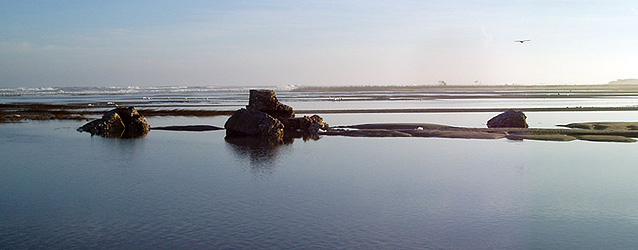Media Included
- Milky Way over Sand Beach - The Milky Way passes over Sand Beach as cars drive by.
The effects of climate change, such as rising sea levels and intensifying storms, will alter the landscape at Assateague Island, affecting the access and experience that visitors enjoy today. The park staff is working to adapt, restore, and protect island resources.
Barrier islands such as Assateague will be especially vulnerable to the effects of climate change and sea-level rise, and we must be able to respond effectively. Trish Kicklighter, Former Superintendent, Assateague Island National Seashore

NPS photo
Assateague Island encompasses 37 miles along the coasts of Maryland and Virginia, part of a chain of barrier islands stretching from Maine to Texas. Its landscape is constantly changing as natural coastal processes, storms, and sea-level rise continue to shape and move the island. Climate change will speed up the normal rate of change, and the staff Assateague Island is working to prepare for its effects.
Scientists project that by 2040 the island will experience increases in temperature and extreme weather, a sea level rise of 3.5–9 inches, and altered precipitation patterns. These changes will magnify the normal coastal processes that shape the island. For example, rising sea levels will increase the rate of overwash—the washing of water and deposition of sand toward the island interior—that allows barrier islands to migrate or rollover westward. Intensifying storms and rising sea levels will create new breaches and inlets.
Responding with Solutions
When natural areas are healthier, they are more resilient and can better withstand the stresses placed on them by climate change. At Assateague Island, improving the ecological health of the island and its surrounding waters are more important than ever. Staff focus their efforts in three main areas:
- Adapt: As storms intensify and sea level rises, new park structures—such as light-weight changing rooms, passive-solar vault toilets, and a solar-powered shower at Tom’s Cove, Virginia—are designed so they can be moved. Parking areas are made of crushed clam shells that reduce storm runoff and are more sustainable than asphalt.
- Restore: In the salt marsh, man-made ditches built in the 1930s are being filled in to reduce erosion. In addition, stands of phragmites, an invasive grass that displaces native species, are being moved to promote resiliency.
- Protect: Wire exclosures are placed around federally threatened species such as piping plover and sea beach amaranth. These exclosures protect species from predation and other disturbances.
Learn More
Still curious about the effects of sea level rise on Assateague Island? Visit the Barrier Islands and Sea Level Rise educational module for more information. Here you can watch movies about the effects of sea level rise on habitats and recreational activities, explore natural resources, and access classroom resources and additional references.
Last updated: February 4, 2015
